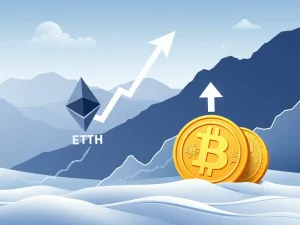Triumph: Tether’s USDt Market Cap Hits $150 Billion Amidst US Expansion Push

The world of digital assets is constantly evolving, and recent news highlights a significant milestone for the largest player in the stablecoin market. Tether’s flagship stablecoin, USDt, has officially surpassed a staggering $150 billion market cap for the first time. This achievement underscores the growing reliance on stablecoins within the crypto ecosystem and sets the stage for Tether’s ambitious plans, including a potential foray into the United States market.
USDt’s Dominance and Market Cap Growth
USDt reaching a $150 billion market cap is a major event, showcasing its integral role in global cryptocurrency trading and liquidity. Despite facing various restrictions and scrutiny in some developed markets, USDt maintains a commanding position. According to CoinMarketCap data, Tether currently accounts for approximately 61% of the total stablecoin market by circulating supply. Its closest competitor, Circle’s USDC, holds roughly 25%.
Over the past year, USDt’s circulating supply has seen substantial growth, expanding by over 36%. This growth notably accelerated following events like the US presidential election cycle in November, suggesting a correlation between macroeconomic and political factors and stablecoin demand.
Why Stablecoins Matter: A Barometer for Crypto Demand
As the largest stablecoin, Tether is often viewed as a key indicator for overall cryptocurrency demand. Its primary function is to provide stability and ease of transfer within volatile crypto markets, serving as a crucial on-ramp and off-ramp for traders and investors worldwide. The increasing adoption of stablecoins broadly reflects a wider trend towards digital fiat currencies and tokenized value.
Data from platforms like Dune and Artemis further supports this trend, showing a significant surge in active stablecoin wallets. The number has grown by more than 50% over the past year, from 19.6 million to 30 million. This expansion in user base indicates a deepening integration of stablecoins into various decentralized finance (DeFi) applications and everyday crypto transactions.
Tether Eyes US Expansion
Despite its global dominance, Tether’s direct usage has faced limitations within the United States. However, with the US becoming a focal point for potential pro-crypto legislation, Tether is actively exploring avenues for entry. The company is reportedly planning to launch a new dollar-backed stablecoin specifically designed for the US market later this year.
Tether CEO Paolo Ardoino has indicated that a domestic US stablecoin would operate differently from its existing international offering. This strategic move aligns with Tether’s broader goal of expanding its reach and influence in key economic regions.
Navigating the US Regulatory Landscape
Entering the US market requires navigating a complex and evolving regulatory landscape. Tether is increasing its lobbying efforts in Washington as lawmakers consider several stablecoin-related bills. One notable piece of proposed legislation is the STABLE Act, introduced by key figures in the House Financial Services Committee.
However, the STABLE Act has drawn criticism from various experts. Former Commodity Futures Trading Commission Chair Timothy Massad, for instance, expressed concerns during a House hearing. He argued that the bill might not adequately address risks posed by large stablecoin issuers like Tether, citing potential weaknesses in state-level standards and a lack of sufficient ongoing federal oversight.
Conclusion
Tether’s USDt hitting a $150 billion market cap is a testament to the stablecoin’s enduring utility and the growing demand for stable digital assets globally. This milestone arrives as Tether strategically positions itself for potential US expansion, a move that could significantly impact the stablecoin market and the broader crypto industry. While regulatory challenges in the US remain a hurdle, Tether’s pursuit of a domestic stablecoin highlights its ambition to solidify its leadership in the digital finance space.









